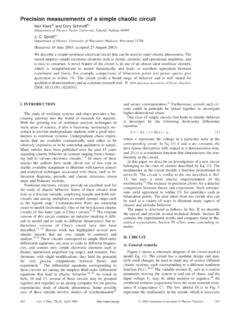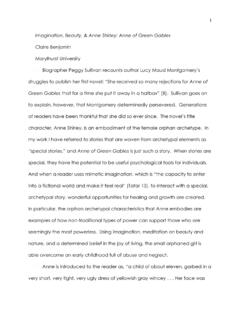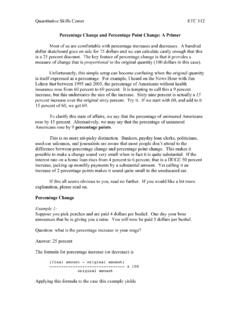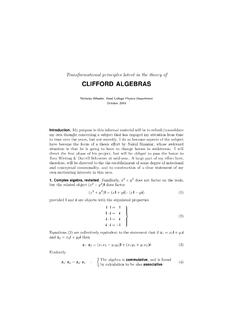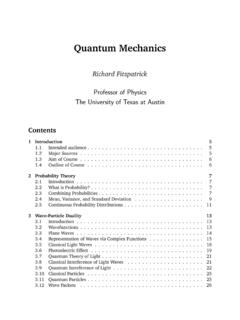Transcription of Harmonic Oscillator Physics
1 Physics 342 lecture 9. Harmonic Oscillator Physics lecture 9. Physics 342. quantum mechanics I. Friday, February 12th, 2010. For the Harmonic Oscillator potential in the time-independent Schro dinger equation: 1 2 d (x). 2.. ~ + m x (x) = E (x), 2 2 2. ( ). 2m dx2. we found a ground state m x2. 0 (x) = A e 2~ ( ). with energy E0 = 1. 2 ~ . Using the raising and lowering operators 1. a+ = ( i p + m x). 2~m . ( ). 1. a = (i p + m x), 2~m . we found we could construct additional solutions with increasing energy using a+ , and we could take a state at a particular energy E and construct solutions with lower energy using a.
2 The existence of a minimum energy state ensured that no solutions could have negative energy and was used to define 0 1 : 1.. a 0 = 0 H (a+ 0 ) =. n + n ~ an+ 0 . ( ). 2. The operators a+ and a are Hermitian conjugates of one another for any 1. I am leaving the hats ` off, from here on we understand that H represents a differ- . ential operator given by H x, ~i x for a classical Hamiltonian. 1 of 10. NORMALIZATION lecture 9. f (x) and g(x) (vanishing at spatial infinity), the inner product: g(x). Z Z . f (x) a g(x) dx = f (x) ~ + m x g(x) dx x f (x). Z .. = ~ g(x) + f (x) m x g(x) dx x Z . = (a f (x)) g(x) dx.
3 ( ). (integration by parts) or, in words, we can act on g(x) with a or act on f (x) with a in the inner product. Normalization The state n that comes from n applications of an+ is not normalized, nor does the eigenvalue form of the time-independent Schro dinger equation de- mand that it be. Normalization is the manifestation of our probabilistic interpretation of | (x, t)|2 . Consider the ground state, that has an undeter- mined constant A. If we want | (x, t)|2 to represent a probability density, then Z . m x2. A2 e ~ dx = 1, ( ).. and the left-hand side is a Gaussian integral: r ~. Z . m x2.
4 A2 e ~ dx = A2 , ( ). m . 1/4. so the normalization is A = m . Just because we have normalized the . ~. ground state does not mean that 1 a+ 0 (x) is normalized. Indeed, we have to normalize each of the n (x) separately. Fortunately, this can be done once (and for all). R . Suppose we have a normalized set of n , n2 dx = 1 for all n = 0 .. We know that n 1 = a n where the goal is to find the constants associated with raising and lowering while keeping the wavefunctions normalized. Take the norm of the resulting raised or lowered state: Z Z . | n 1 |2 dx = 2. (a n (x)) (a n (x)) dx . Z ( ).. = 2.
5 (a a n (x)) n (x) dx, . 2 of 10. ORTHONORMALITY lecture 9. and the operator a a is related to the Hamiltonian, as we saw last time: H = ~ a a 12 . Then H 1 1 1.. a a n = n = +n n , ( ). ~ 2 2 2. so ( ) becomes 1 1. Z Z .. 2. (a a n (x)) n (x) dx = . 2. +n | n (x)|2 dx. 2 2 . R ( ). The integral | n (x)|2 dx = 1 by assumption, so we have 1 1. + = = , ( ). n+1 n and our final relation is 1 1. n+1 = a+ n n 1 = a n . ( ). n+1 n Starting from the ground state, for which we know the normalization, 1 = a+ 0. 1 1. 2 = a+ 1 = a2+ 0. 2 1 2 ( ). 1 1. 3 = a+ 2 = a3+ 0 . 3 1 2 3. The general case is 1. n = an+ 0 ( ).
6 N! for the appropriately normalized 0 , m 1/4 m x2. 0 (x) = e 2 ~ . ( ). ~. Orthonormality The states described by n are complete (we assume) and orthonormal . take our usual inner product for m and n : 1 1. Z Z. n m = n (x) m (x) dx = (an+ 0 ) (am + 0 ) dx. m! n! . ( ). 3 of 10. ORTHONORMALITY lecture 9. Now, suppose m > n, then using the fact that a+ and a are Hermitian conjugates, we can flip the am + onto the other term: 1 1 1 1. Z Z.. (a+ 0 ) (a+ 0 ) dx = . n m (am a+ 0 ) ( 0 ) dx, n m! n! m! n! . ( ). and we know that an+ 0 n and am n n m but for m > n, we have a 0 = 0, the defining property of the ground state.
7 In the case m n n > m, we just use the conjugate in the other direction, and make the same argument: 1 1 1 1. Z Z.. (a+ 0 ) (a+ 0 ) dx = . n m ( 0 ) (an am + 0 ) dx = 0. m! n! m! n! . R 2 ( ). Only when m = n will we get a non-zero result, and of course, m dx =. 1 by construction. So Z . n (x) m (x) dx = mn . ( ).. Hermite Polynomials The prescription for generating n does not provide a particularly easy way to obtain the functional form for an arbitrary n we have to repeatedly apply the raising operator to the ground state. There is a connection between the Hermite polynomials and our procedure of lifting up the ground state.
8 Using the Frobenius method, it is possible to solve Schro dinger's equation as a power series expansion (described in Griffiths), and we won't re-live that argument (yet). But it is important to understand the connection between the algebraic, operational approach and the brute force series expansion. Starting from the ground state, let's act with a+ (call the normalization constant A again, just to make the expressions more compact): 1 . 2.. m2 ~x 1 = a+ 0 = ~ + m x Ae 2m ~ x ( ). A m . r 2. m2 ~x = 2 x e . 2 ~. 4 of 10. ORTHONORMALITY lecture 9. Consider the second state, 1 1 1 A m . r . m x2.
9 2 = a+ 1 = ~ + m x 2 x e 2 ~. 2 2 2m ~ x 2 ~. A 2x 2.. m x = e 2 ~ ~. 2 2 x ~. 1 m 1 A m x2. r . + 2 x ~ + m x e 2 ~. 2 ~ 2m ~ x 2. 2. A A m . 2. r 2. m x m x = e 2 ~ ( 2) + 2 x e 2 ~. 2 2 2 2 ~. A m 2 m x2. = 4 x 2 e 2 ~ . 2 2 ~. ( ). The pattern continues we always have some polynomial in x multiplying the exponential factor. That polynomial, for the nth wave function p is called Hn , the nth Hermite polynomial. In the dimensionless variable = m~ x, we can read off the first two H1 ( ) = 2 , and H2 ( ) = 4 2 2. Normalized, we have the expression m 1/4 1 2. n (x) = Hn ( ) e 2 ( ). ~ 2n n! with H0 ( ) = 1.
10 H1 ( ) = 2 . H2 ( ) = 4 2 2 ( ). H3 ( ) = 8 12 . 3.. This set of polynomials is well-known, and they have a number of interesting recursion and orthogonality properties (many of which can be developed from the a+ and a operators). One still needs a table of these in order to write down a particular n , but that's better than taking n successive derivatives of 0 in essence, the Hermite polynomials have accomplished that procedure for you. Once again, we can plot the first few wavefunctions (see Figure ), and as we increase in energy, we see a pattern similar to the infinite square well case (note that for the Harmonic Oscillator , we start with n = 0 as the ground state rather than 1).


